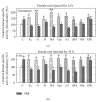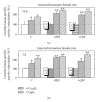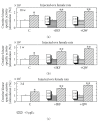The response of creatine kinase specific activity in rat pituitary to estrogenic compounds and vitamin d less-calcemic analogs
- PMID: 20111624
- PMCID: PMC2809427
- DOI: 10.1155/2009/273651
The response of creatine kinase specific activity in rat pituitary to estrogenic compounds and vitamin d less-calcemic analogs
Abstract
We examined the response of rat female pituitary at different metabolic stages to treatments with estrogenic compounds and vitamin D analogs. Immature or ovariectomized (Ovx) female rats responded by increased creatine kinase specific activity (CK) to estradiol-17beta (E(2)), genistein (G), daidzein (D), biochainin A (BA), quecertin (Qu), carboxy- G (cG), carboxy- BA (cBA), and raloxifene (Ral). The response was inhibited when Ral was injected together with the estrogens. CK was increased when hormones were injected daily into Ovx rats for 4 different time periods. Pretreatment with the less-calcemic vitamin D analogs JK 1624 F(2)-2 (JKF) or QW 1624 F(2)-2 (QW) followed by estrogenic injection resulted in increased response and sensitivity to E(2) and loss of inhibition of E(2) by Ral. CK was also increased by feeding with E(2) or licorice or its components dose- and time- dependent in immature or Ovxrats. Diabetic female rats did not respond to increased doses of E(2). In conclusion, rat female pituitary is estrogens-responsive organ, suggesting to considerits response for HRT in postmenopausal women for both beneficial and hazardous aspects.
Figures










Similar articles
-
Responsiveness to phytoestrogens in primary human osteoblasts is modulated differentially by a "less-calcemic" analog of 1,25 dihydroxyvitamin D(3): JK 1624F(2)-2 (JKF).J Steroid Biochem Mol Biol. 2006 Feb;98(2-3):139-46. doi: 10.1016/j.jsbmb.2005.08.016. Epub 2006 Jan 10. J Steroid Biochem Mol Biol. 2006. PMID: 16406510
-
Vitamin D modulation of the activity of estrogenic compounds in bone cells in vitro and in vivo.Crit Rev Eukaryot Gene Expr. 2007;17(2):115-47. doi: 10.1615/critreveukargeneexpr.v17.i2.30. Crit Rev Eukaryot Gene Expr. 2007. PMID: 17725484 Review.
-
The effects of native and synthetic estrogenic compounds as well as vitamin D less-calcemic analogs on adipocytes content in rat bone marrow.J Endocrinol Invest. 2011 Feb;34(2):106-10. doi: 10.1007/BF03347039. Epub 2010 Jun 11. J Endocrinol Invest. 2011. PMID: 20543554
-
Responsiveness to estradiol-17beta and to phytoestrogens in primary human osteoblasts is modulated differentially by high glucose concentration.J Steroid Biochem Mol Biol. 2006 May;99(2-3):139-46. doi: 10.1016/j.jsbmb.2005.12.008. Epub 2006 Apr 18. J Steroid Biochem Mol Biol. 2006. PMID: 16621514
-
Calciotrophic hormones and hyperglycemia modulate vitamin D receptor and 25 hydroxyy vitamin D 1-α hydroxylase mRNA expression in human vascular smooth muscle cells.J Steroid Biochem Mol Biol. 2015 Apr;148:210-3. doi: 10.1016/j.jsbmb.2014.11.007. Epub 2014 Nov 13. J Steroid Biochem Mol Biol. 2015. PMID: 25448744 Review.
References
-
- Fink G. Gonadotropin secretion and its control. In: Knobil E, Neill J, editors. The Physiology of Reproduction. New York, NY, USA: Raven Press; 1988. pp. 1349–1377.
-
- Mitchner NA, Garlick C, Ben-Jonathan N. Cellular distribution and gene regulation of estrogen receptors α and β in the rat pituitary gland. Endocrinology. 1998;139(9):3976–3983. - PubMed
-
- Bottner M, Christoffel J, Jarry H, Wuttke W. Effects of long-term treatment with revestratrol and subcutaneous and oral estradiol administration on pituitary function in rats. Journal of Endocrinology. 2006;189:77–88. - PubMed
-
- Mazur W. Phytoestrogen content in foods. Bailliers Clinical Endocrinology and Metabolism. 1998;12(4):729–742. - PubMed
-
- Tham DM, Gardner CD, Haskell WL. Potential health benefits of dietary phytoestrogens: a review of the clinical, epidemiological, and mechanistic evidence. The Journal of Clinical Endocrinology & Metabolism. 1998;83(7):2223–2235. - PubMed
LinkOut - more resources
Full Text Sources
Research Materials

